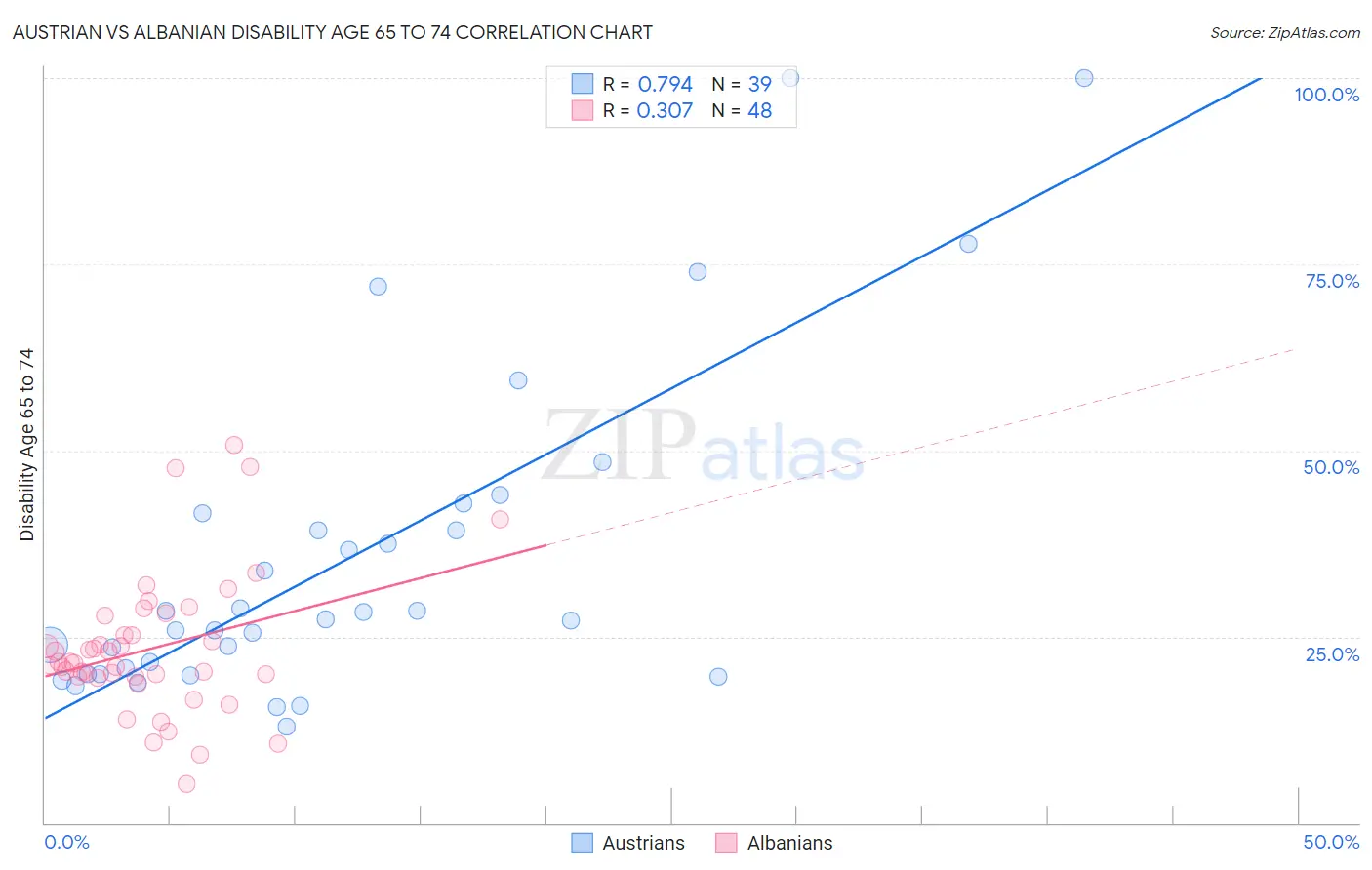Austrian vs Albanian Disability Age 65 to 74
COMPARE
Austrian
Albanian
Disability Age 65 to 74
Disability Age 65 to 74 Comparison
Austrians
Albanians
22.4%
DISABILITY AGE 65 TO 74
94.7/ 100
METRIC RATING
118th/ 347
METRIC RANK
22.3%
DISABILITY AGE 65 TO 74
95.8/ 100
METRIC RATING
109th/ 347
METRIC RANK
Austrian vs Albanian Disability Age 65 to 74 Correlation Chart
The statistical analysis conducted on geographies consisting of 451,186,981 people shows a strong positive correlation between the proportion of Austrians and percentage of population with a disability between the ages 65 and 75 in the United States with a correlation coefficient (R) of 0.794 and weighted average of 22.4%. Similarly, the statistical analysis conducted on geographies consisting of 193,041,250 people shows a mild positive correlation between the proportion of Albanians and percentage of population with a disability between the ages 65 and 75 in the United States with a correlation coefficient (R) of 0.307 and weighted average of 22.3%, a difference of 0.38%.

Disability Age 65 to 74 Correlation Summary
| Measurement | Austrian | Albanian |
| Minimum | 13.0% | 5.2% |
| Maximum | 100.0% | 50.8% |
| Range | 87.0% | 45.6% |
| Mean | 35.5% | 23.3% |
| Median | 27.3% | 21.5% |
| Interquartile 25% (IQ1) | 19.9% | 19.6% |
| Interquartile 75% (IQ3) | 41.5% | 26.5% |
| Interquartile Range (IQR) | 21.6% | 6.9% |
| Standard Deviation (Sample) | 22.0% | 9.3% |
| Standard Deviation (Population) | 21.7% | 9.2% |
Demographics Similar to Austrians and Albanians by Disability Age 65 to 74
In terms of disability age 65 to 74, the demographic groups most similar to Austrians are Swedish (22.4%, a difference of 0.0%), Immigrants from Northern Africa (22.4%, a difference of 0.010%), Brazilian (22.4%, a difference of 0.020%), Laotian (22.3%, a difference of 0.060%), and Ukrainian (22.3%, a difference of 0.12%). Similarly, the demographic groups most similar to Albanians are Immigrants from Peru (22.3%, a difference of 0.050%), Serbian (22.3%, a difference of 0.070%), Immigrants from Zimbabwe (22.3%, a difference of 0.090%), Slovene (22.2%, a difference of 0.10%), and Peruvian (22.2%, a difference of 0.11%).
| Demographics | Rating | Rank | Disability Age 65 to 74 |
| South Americans | 96.4 /100 | #103 | Exceptional 22.2% |
| Colombians | 96.4 /100 | #104 | Exceptional 22.2% |
| Palestinians | 96.3 /100 | #105 | Exceptional 22.2% |
| Peruvians | 96.1 /100 | #106 | Exceptional 22.2% |
| Slovenes | 96.1 /100 | #107 | Exceptional 22.2% |
| Immigrants | Zimbabwe | 96.1 /100 | #108 | Exceptional 22.3% |
| Albanians | 95.8 /100 | #109 | Exceptional 22.3% |
| Immigrants | Peru | 95.7 /100 | #110 | Exceptional 22.3% |
| Serbians | 95.7 /100 | #111 | Exceptional 22.3% |
| Immigrants | South America | 95.5 /100 | #112 | Exceptional 22.3% |
| Syrians | 95.3 /100 | #113 | Exceptional 22.3% |
| Ukrainians | 95.1 /100 | #114 | Exceptional 22.3% |
| Laotians | 94.9 /100 | #115 | Exceptional 22.3% |
| Brazilians | 94.8 /100 | #116 | Exceptional 22.4% |
| Swedes | 94.7 /100 | #117 | Exceptional 22.4% |
| Austrians | 94.7 /100 | #118 | Exceptional 22.4% |
| Immigrants | Northern Africa | 94.7 /100 | #119 | Exceptional 22.4% |
| Immigrants | Kazakhstan | 93.9 /100 | #120 | Exceptional 22.4% |
| Czechs | 93.5 /100 | #121 | Exceptional 22.4% |
| Immigrants | Jordan | 93.5 /100 | #122 | Exceptional 22.4% |
| Hungarians | 93.3 /100 | #123 | Exceptional 22.4% |